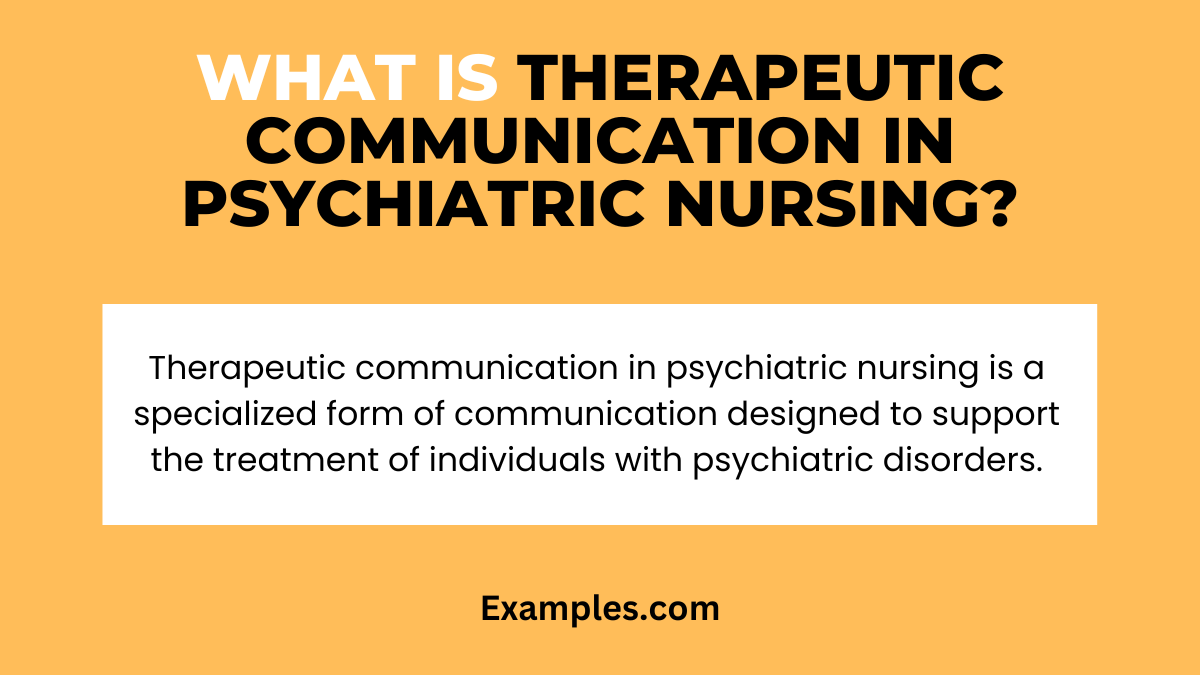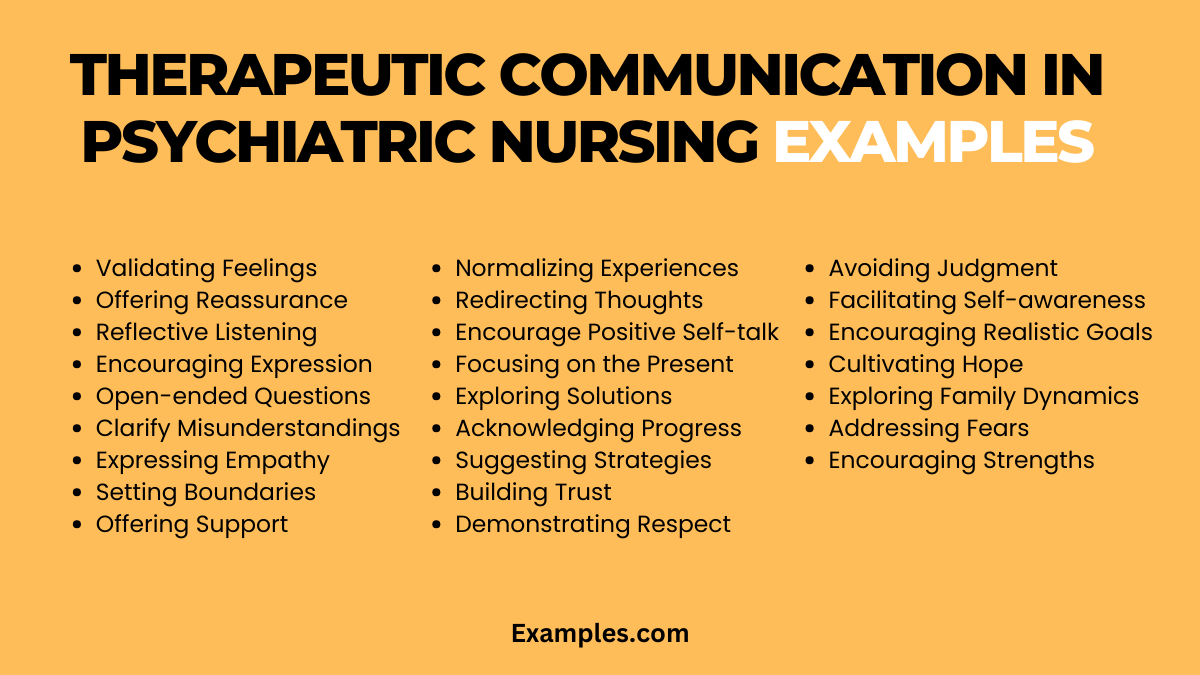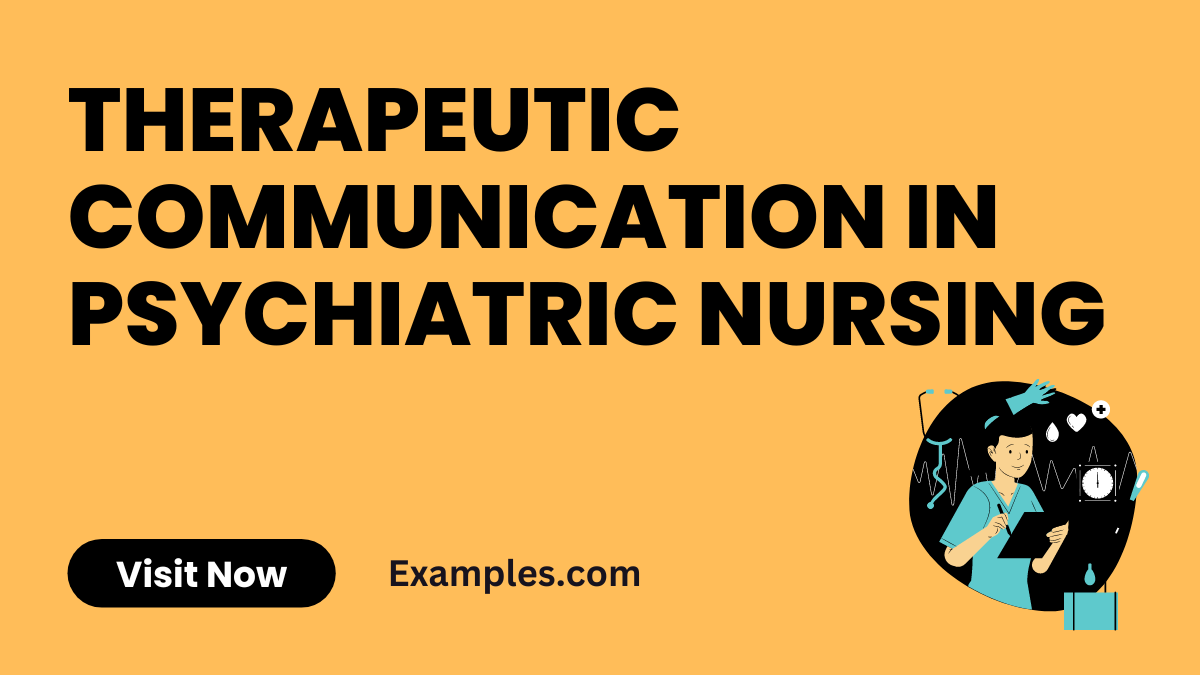24+ Therapeutic Communication in Psychiatric Nursing Examples
Therapeutic communication in psychiatric nursing is a vital aspect of patient care, fostering a healing and supportive environment. This guide delves into the nuances of such interactions, offering communication examples and techniques specific to psychiatric settings. It emphasizes the importance of building rapport, understanding patient needs, and employing empathy and active listening. With a focus on both verbal and nonverbal cues, this guide serves as an essential resource for nurses to effectively engage with patients, enhancing the overall quality of psychiatric care and fostering positive patient outcomes.
What is Therapeutic Communication in Psychiatric Nursing?

Therapeutic communication in psychiatric nursing is a specialized form of communication designed to support the treatment of individuals with psychiatric disorders. It involves using specific communication techniques to establish a rapport with patients, encouraging them to express their thoughts and feelings in a safe, non-judgmental environment. This type of communication is characterized by empathy, respect, and genuineness. It aims to understand the patient’s perspective, provide emotional support, and facilitate positive changes in their mental health. It’s a critical tool for psychiatric nurses to establish trust and promote healing.
Importance in Patient Care
This communication style is crucial for establishing trust and rapport with patients. It aids in understanding their unique mental health challenges, playing a key role in effective patient care and treatment planning.
Core Principles
The core principles of therapeutic communication in psychiatric nursing include empathy, respect, and active listening. These principles are essential for creating a safe and supportive environment for patients.
Role in Treatment
Therapeutic communication is integral to the overall treatment process. It helps in assessing patients’ mental health, delivering appropriate care, and enhancing treatment outcomes.
Impact on Recovery
Effective communication in psychiatric nursing can significantly impact a patient’s recovery journey. It provides support, reduces feelings of isolation, and helps in navigating the complexities of mental health conditions.
25 Therapeutic Communication in Psychiatric Nursing Examples

Therapeutic communication in psychiatric nursing is a critical aspect of patient care, promoting healing, comfort, and understanding in a challenging healthcare setting. This guide provides 30 distinct examples, demonstrating how effective communication can be employed to foster trust, empathy, and positive patient outcomes in psychiatric environments.
- Validating Feelings: “I understand that you’re feeling overwhelmed right now, and that’s completely okay.”
Acknowledging the patient’s emotions, reassuring them that their feelings are valid. - Offering Reassurance: “We’re here to support you through this journey.”
Providing comfort and reassurance to alleviate anxiety and fear. - Reflective Listening: “It sounds like you’re feeling anxious about the future?”
Mirroring the patient’s words to show understanding and encourage further sharing. - Encouraging Expression: “Would you like to talk more about your feelings right now?”
Inviting the patient to share more about their emotions and experiences. - Using Open-ended Questions: “Can you tell me more about what you’re experiencing?”
Facilitating a broader and deeper conversation about the patient’s state. - Clarifying Misunderstandings: “Let me make sure I understand, you’re saying…”
Ensuring there’s no miscommunication and the patient’s message is clearly understood. - Expressing Empathy: “I can see how that situation could be very distressing for you.”
Demonstrating empathy and understanding of the patient’s situation. - Setting Boundaries: “Let’s focus on your feelings right now, rather than what others are doing.”
Redirecting the conversation to the patient’s emotions and maintaining a therapeutic focus. - Offering Support: “I’m here for you, and we will work through these challenges together.”
Providing emotional support and a sense of partnership in the treatment process. - Normalizing Experiences: “Many people feel this way in similar situations.”
Helping the patient understand that their feelings or reactions are normal. - Redirecting Negative Thoughts: “Let’s try to look at this from a different perspective.”
Guiding the patient to consider alternative viewpoints or more positive aspects. - Encouraging Positive Self-talk: “What are some good things you can say about yourself?”
Promoting self-compassion and a positive self-image. - Focusing on the Present: “Let’s talk about how you’re feeling right now.”
Steering the conversation to the current moment and emotions. - Exploring Solutions: “What are some ways you think might help you feel better?”
Collaborating with the patient to identify potential coping strategies or solutions. - Acknowledging Progress: “You’ve made some significant improvements in how you handle stress.”
Recognizing and reinforcing the patient’s progress and efforts. - Suggesting Coping Strategies: “Have you tried relaxation techniques when you feel anxious?”
Offering practical suggestions for managing symptoms or stressors. - Building Trust: “You can trust me, everything we discuss here is confidential.”
Establishing trust and a safe space for open communication. - Demonstrating Respect: “I respect your views and want to understand your perspective.”
Showing respect for the patient’s opinions and experiences. - Avoiding Judgment: “It’s understandable to feel that way given your situation.”
Creating a non-judgmental environment where the patient feels comfortable sharing. - Facilitating Self-awareness: “How do you feel after discussing these thoughts?”
Encouraging the patient to reflect on their emotions and the discussion’s impact. - Encouraging Realistic Goals: “What is one small step you feel you can achieve today?”
Motivating the patient to set achievable and realistic goals. - Cultivating Hope: “Together, we can find ways to improve how you’re feeling.”
Fostering a sense of hope and optimism in the treatment process. - Exploring Family Dynamics: “How does your family situation affect how you feel?”
Examining the impact of family relationships on the patient’s mental health. - Addressing Fears: “What are some fears you have about the future?”
Inviting the patient to express and confront their fears. - Encouraging Personal Strengths: “What are some strengths you have that can help you in this situation?”
Highlighting and building upon the patient’s strengths and abilities.
What are Therapeutic Communication Techniques in Psychiatric Nursing?
Here are the techniques of Therapeutic Communication in Psychiatric Nursing:
Active Listening
Active listening involves giving full attention to the patient, showing understanding, and responding thoughtfully. It’s a key technique that fosters trust and engagement in psychiatric care.
Empathy and Validation
Empathizing with patients and validating their feelings are essential techniques. They help in building a rapport and demonstrating compassion and understanding.
Open-Ended Questions
Using open-ended questions encourages patients to express their thoughts and feelings more freely. This approach facilitates deeper understanding and better patient engagement.
Reflective Statements
Reflective statements involve mirroring back what the patient has said, which helps in confirming understanding and ensuring patients feel heard.
Use of Therapeutic Silence
Therapeutic silence provides a powerful tool, giving patients space to process their thoughts and feelings. It can be a catalyst for self-reflection and insight in psychiatric settings.
How to Use Therapeutic Communication in Psychiatric Nursing?
Here is an instructions to follow while using Therapeutic Communication in Psychiatric Nursing:
Establishing a Therapeutic Environment
Create a safe and comfortable environment for open communication. This includes respecting personal space and maintaining a calm and soothing demeanor.
Using Open-Ended Questions
Open-ended questions encourage patients to elaborate on their thoughts and feelings, fostering deeper understanding and enhancing patient-nurse interaction.
Reflecting and Paraphrasing
Reflecting and paraphrasing help in demonstrating understanding and ensuring clarity in communication, which is vital for accurate assessment and effective support.
Offering Reassurance and Support
Providing reassurance and support reinforces the patient’s value and instills hope, essential in promoting healing and building confidence.
Exploring Feelings and Experiences
Encouraging patients to explore and express their feelings and experiences aids in better understanding their mental state and tailoring care accordingly.
Collaborating in Care Planning
Involving patients in care planning fosters autonomy and empowerment, crucial for patient-centered care and enhanced treatment outcomes.
In conclusion, therapeutic communication in psychiatric nursing plays a pivotal role in patient care, particularly in fostering a healing and supportive environment. This specialized form of communication is characterized by empathy, respect, and genuineness, aiming to understand the patient’s perspective and facilitate positive changes in their mental health. It’s a critical tool for psychiatric nurses, as it establishes trust, reduces anxiety, and supports the overall treatment process, enhancing patient outcomes.
Moreover, effective communication in psychiatric nursing can significantly impact a patient’s recovery journey. It provides essential support, reduces feelings of isolation, and assists in navigating the complexities of mental health conditions. By mastering these communication techniques, psychiatric nurses significantly contribute to the well-being and recovery of their patients, making therapeutic communication an indispensable aspect of psychiatric care.
For further insights and resources on therapeutic communication in psychiatric nursing, the American Psychiatric Association offers valuable information and guidance for annual meeting. Additionally, the National Institute of Mental Health provides extensive resources on psychotherapies, including aspects of therapeutic communication (National Institute of Mental Health). These resources can be instrumental for healthcare professionals seeking to deepen their understanding and skills in this crucial area of mental health care.



